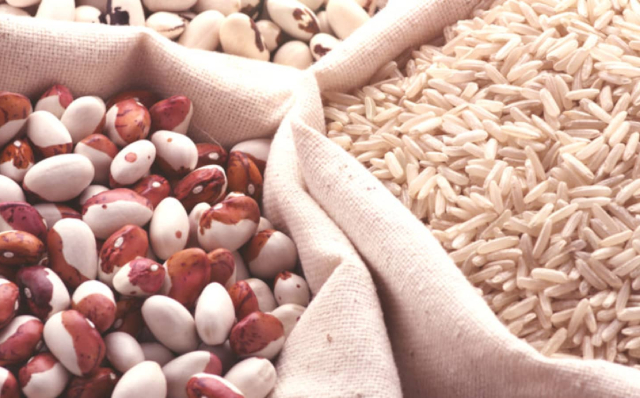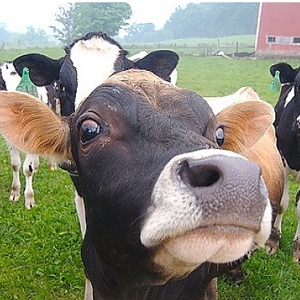They’ve been telling us to expect it for months – actually more than two years, now – and it’s finally coming to pass, big time. Canadians (and, we can assume, Americans by association) are making big concessions and outright changes to their food-buying habits to make ends meet…
 Rice and Beans: The classic, ages-old combination billions of folks around the world rely on
Rice and Beans: The classic, ages-old combination billions of folks around the world rely on
to get a complete, nourishing protein complex every day. And then, there’s lentils and
quinoa, and soy products… Time to join the majority at the dinner table?
A new Angus Reid poll of Canadian households reveals some sobering facts about our eating and food-buying habits.The overall message. Four out of 5 Canadian households are making changes to their families’ menus to make ends meet in the face of rising food costs.
Some standout highlights
- 62 percent report eating out less
- 25 percent are drinking less alcohol
- 46 percent say they’re switching to cheaper brands of the foods they can’t do without
- 35 percent are cutting back on meat
- 21 percent are buying less fresh fruit and veggies
That last point is perhaps the most troubling one, as the most recent versions of the official dietary and eating guidelines for all western countries have noted that we need to eat more fresh produce. If high meat prices are encouraging people to cut back in that department, it’s (arguably) a good thing. I’ve seen no numbers on whether Canadians are buying more or fewer plant proteins, grains and pulses. But I suspect, since plant protein products are still new (and suspect) to most Westerners, and those that mimic the qualities of real meat are still priced well above real meat, the answer is less, rather than more.
Having trouble feeding the family
The poll shows that more than half those surveyed in BC, Saskatchewan, Manitoba and the Maritimes said they’re having trouble affording enough decent food to feed their families. Overall, more than 40 percent of Canadians say they’re having trouble stretching their food budgets to meet their needs. That’s a shocker to me – and, I’m sure, to others who’ve assumed that Canada is an advanced, developed, relatively wealthy society which takes care of its own.
Supply management controversy reemerging
In Canada, dairy products (among other agricultural sectors) are subject to a system called Supply Management. Under the system, farmers are issued quotas designed to restrict production and, hand in hand with high import tariffs on food, keep prices up. The system was originally implemented to protect Canadian farmers from damaging competition from imports from the U.S. and other sources, where the usual self-regulating supply-and-demand balance was in effect. Under classic supply-and-demand, farmers had to be efficient, keep costs down and keep production up to stay competitive with their fellow Canadian producers as well as foreign imports. Good farmers thrived; bad farmers perished. Survival of the fittest.
The Angus Reid poll report notes that supply management costs Canadian consumers more than $2.6 billion a year in artificially high prices: “The price floor set by supply management for Canadian farmers’ dairy, egg and poultry products increases the price Canadian consumers pay for these goods. And just recently, the farm gate price of milk – that is, the price farmers are paid for milk to sell to processors – has increased by 8.4 per cent on Feb. 1. This adds to the pressure Canadians are facing from inflation, which drove grocery prices up in 2021 and is expected to add nearly $1,000 to the average family of four’s grocery bill in 2022.”
No wonder, “Across the country, in every province a majority would like to see a temporary pause – or supply management be done away with completely.”
My take
I’ve already injected comments of my own at strategic points throughout this post. But I want to close with a couple of overarching observations.
First, I wholeheartedly endorse websites like thefinancialdiet.com, which offer common sense, doable ways to stretch tour food dollars and make better use of the food you do buy. Following the advice on these sites can also help us all waste less and enjoy more!
And here’s a website that spotlights the cheapest, healthiest foods you can buy… You’ll have be flexible in your buying and eating habits – but you’re doing that already, according to Angus Reid, aren’t you?
Second, it seems crazy not to at least ease supply management and price setting controls to help Canadians afford to feed their families in the face of the worst inflation in decades. Even the cows must be asking, “Why not?” (See photo, top of page.)
Third, I thought the government was supposed to represent and stand up for and protect and serve all Canadians – not just a few thousand farmers. I mean – WOW! – I wish I had a guaranteed income like the dairy, poultry and egg producers…
~ Maggie J.

